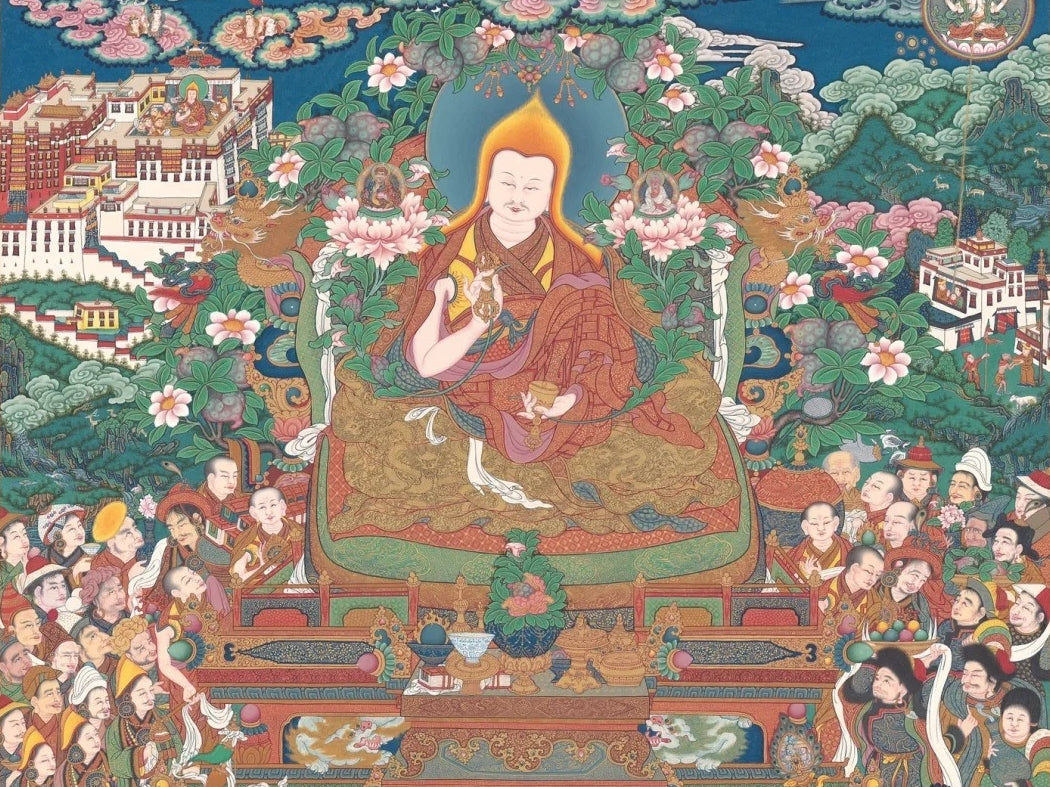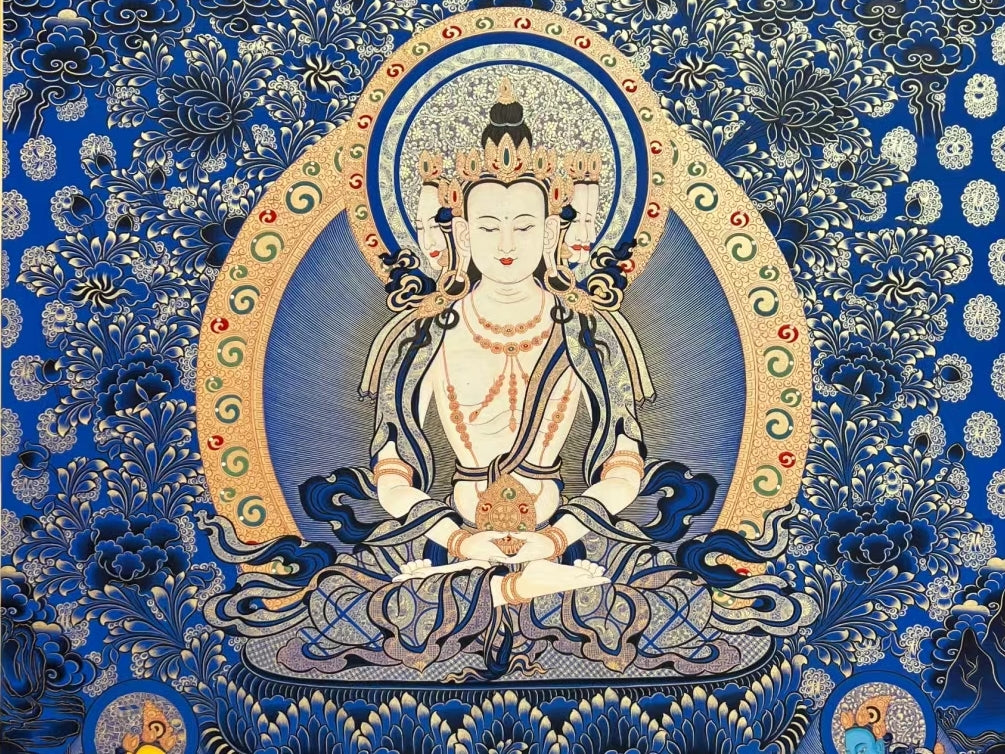The Significance of Mahasthamaprapta in Buddhist Tradition
While Mahasthamaprapta, a bodhisattva who is one of the Western Three Sages, might not be as widely known as Amitabha Buddha or Avalokiteshvara (Guanyin, 观音), his role is equally significant. Like Avalokiteshvara, Mahasthamaprapta serves alongside Amitabha Buddha as an attendant in the Western Pure Land (Sukhavati). His name, "Mahasthamaprapta," is a Sanskrit term that can be translated as "Great Strength" or "Great Perseverance," and he is responsible for bridging the human realm with the heavens.
According to the Infinite Life Sutra (观无量寿经), it is said:
“Mahasthamaprapta, through the radiance of his boundless wisdom, illuminates the world, enabling all beings to be freed from the calamities of war and bloodshed, attaining supreme power.”

The Origins of His Name
In the Sutra of the Lotus of Compassion (悲华经), it is recorded that during the time of the Treasure Store Buddha, Amitabha Buddha was a Wheel-Turning King. Avalokiteshvara was the first prince, and Mahasthamaprapta was the second. When Treasure Store Buddha prophesied that Amitabha and Avalokiteshvara would achieve enlightenment, Mahasthamaprapta made a great vow. He declared that after Avalokiteshvara attains Buddhahood and enters nirvana, he would follow in his footsteps, uphold the Dharma, and preserve it.
Mahasthamaprapta vowed:
“When I become a Buddha, the propagation of Dharma and the purity of my land shall be equal in every way to that of Avalokiteshvara, who will become the Buddha of Universal Light and Merit.”
Treasure Store Buddha was pleased with Mahasthamaprapta’s vow and predicted that he would become a Buddha in the future with the name "Virtuous Treasure Mountain Tathagata" (善住珍宝山如来). Due to his vow to bring about a pure, magnificent world, he was given the name "Mahasthamaprapta," meaning "One Who Attains Great Strength."

The Meaning Behind Mahasthamaprapta's Name
The significance of Mahasthamaprapta’s name is discussed in several sutras. In the Infinite Life Sutra (观无量寿经), it is stated:
“With the radiance of his wisdom, he illuminates all beings, freeing them from the three realms of suffering and granting them supreme power. Thus, he is known as Mahasthamaprapta.”
Mahasthamaprapta’s wisdom is vast and immeasurable. He is also referred to as the "Bodhisattva of Boundless Light" (无边光菩萨) because his wisdom enables sentient beings to escape the three lower realms (hell, hungry ghosts, and animals) and achieve boundless power. His spiritual might dispels all evil forces.
Additionally, the sutra states:
“Through the power of wisdom, Mahasthamaprapta eradicates the suffering of the three lower realms and grants supreme joy, thus earning the name Mahasthamaprapta.”
In the Sutra of Benefits (思益经), it says:
“When I step foot upon the earth, the three thousand worlds and the palaces of demons tremble. Thus, I am called Mahasthamaprapta.”
It is believed that when we encounter obstacles, we can chant Mahasthamaprapta’s name, invoking his light and power to overcome difficulties and eliminate evil forces.
The Incomparable Mindfulness of Buddha Samadhi
The Surangama Sutra (楞严经) discusses the concept of "perfect penetration" in relation to the eighteen realms (six sense organs, six sense objects, and six consciousnesses) and the seven great elements (earth, water, fire, wind, space, sight, and consciousness). Two of the most renowned methods are Avalokiteshvara’s "Ear Gate Penetration" and Mahasthamaprapta’s "Mindfulness of Buddha" practice. These methods are well-suited to beings in our world (Saha World), as sentient beings here are particularly responsive to practices involving sound.
The Surangama Sutra, specifically the chapter "Mahasthamaprapta's Perfect Penetration" (大势至菩萨圆通章), explains the essential teachings of Buddha mindfulness in 289 characters. The core principle is likened to a child remembering their mother:
“Just as a child recalls their mother, so too should we remember the Buddha with deep mindfulness. Through this, we can be certain to see the Buddha and never be far from him.”
By remembering and chanting the Buddha’s name in this manner, one can “gather the six sense faculties and maintain pure mindfulness,” eventually attaining the samadhi of Buddha mindfulness.
The Sacred Bottle on His Crown
Mahasthamaprapta’s appearance is almost identical to that of Avalokiteshvara, with one key difference: while Avalokiteshvara wears a crown adorned with a Buddha image, Mahasthamaprapta’s crown features a precious bottle.
A beautiful story accompanies this bottle. During his practice as a bodhisattva, Mahasthamaprapta lost his parents at an early age. To honor his parents, he placed their remains in a bottle atop his head, committing to spiritual practice and dedicating his merit to them. Over time, the bones within the bottle transformed, and even the bottle itself became a treasure.
Eventually, the bones radiated light, a sign of Mahasthamaprapta’s deep filial piety. This light, capable of reflecting all Buddha teachings, became a symbol of his wisdom and compassion.

The Thangka Jewelry Connection: A Spiritual Reminder
As Mahasthamaprapta is the guardian for those born under the Chinese zodiac sign of the Horse, wearing Thangka jewelry that features his likeness or symbolic imagery can serve as a constant spiritual reminder. It embodies strength, wisdom, and perseverance, offering wearers not only a beautiful piece of jewelry but also a meaningful connection to their spiritual practice.
By incorporating the image of Mahasthamaprapta into Thangka jewelry—such as Thangka pendant necklaces—you’re embracing not just a stunning accessory but also a rich, ancient history filled with spiritual meaning. Whether as a personal symbol of strength or as a gift to others, Thangka jewelry serves as a reminder of the wisdom, power, and compassion of Mahasthamaprapta.




